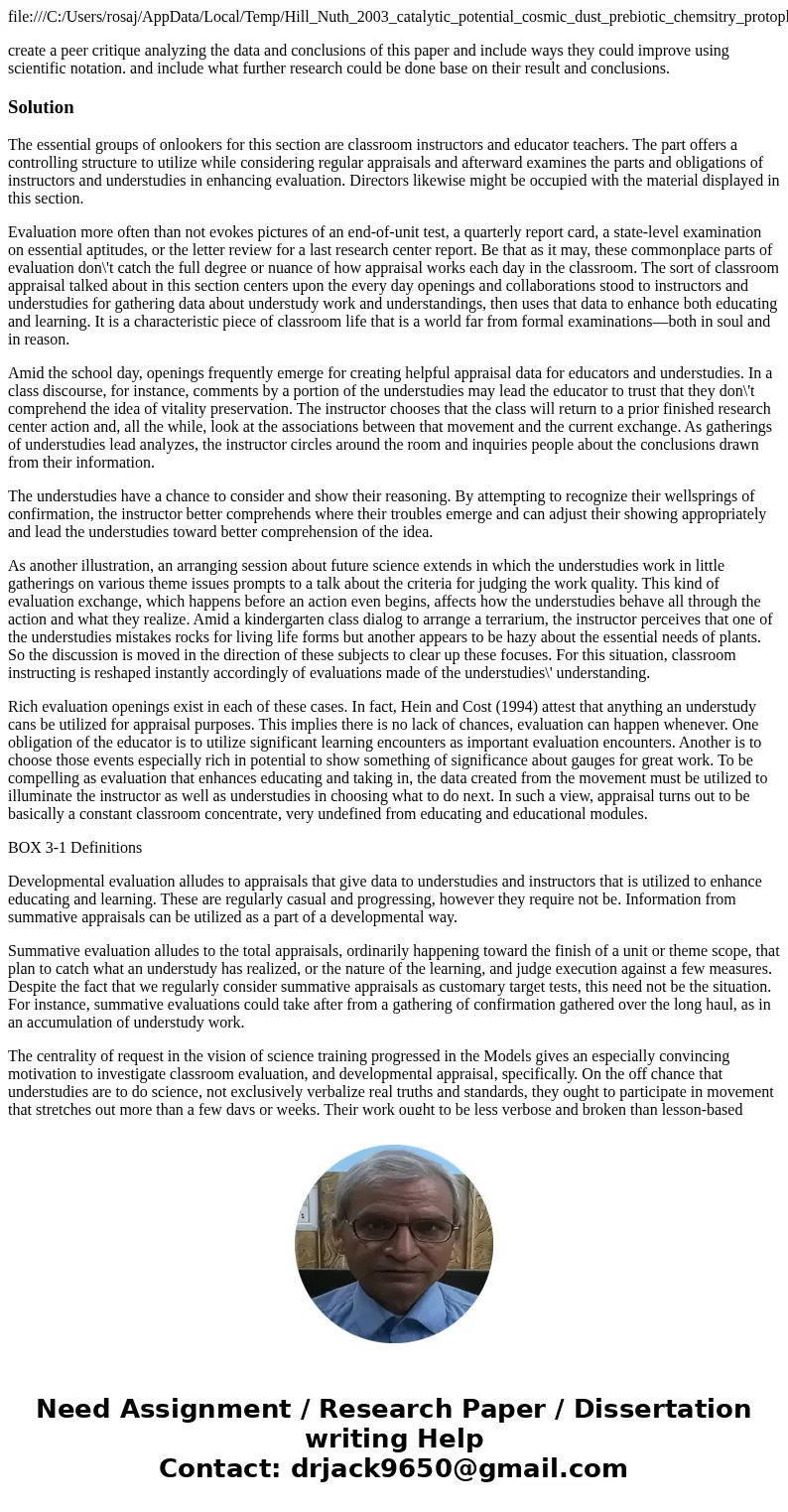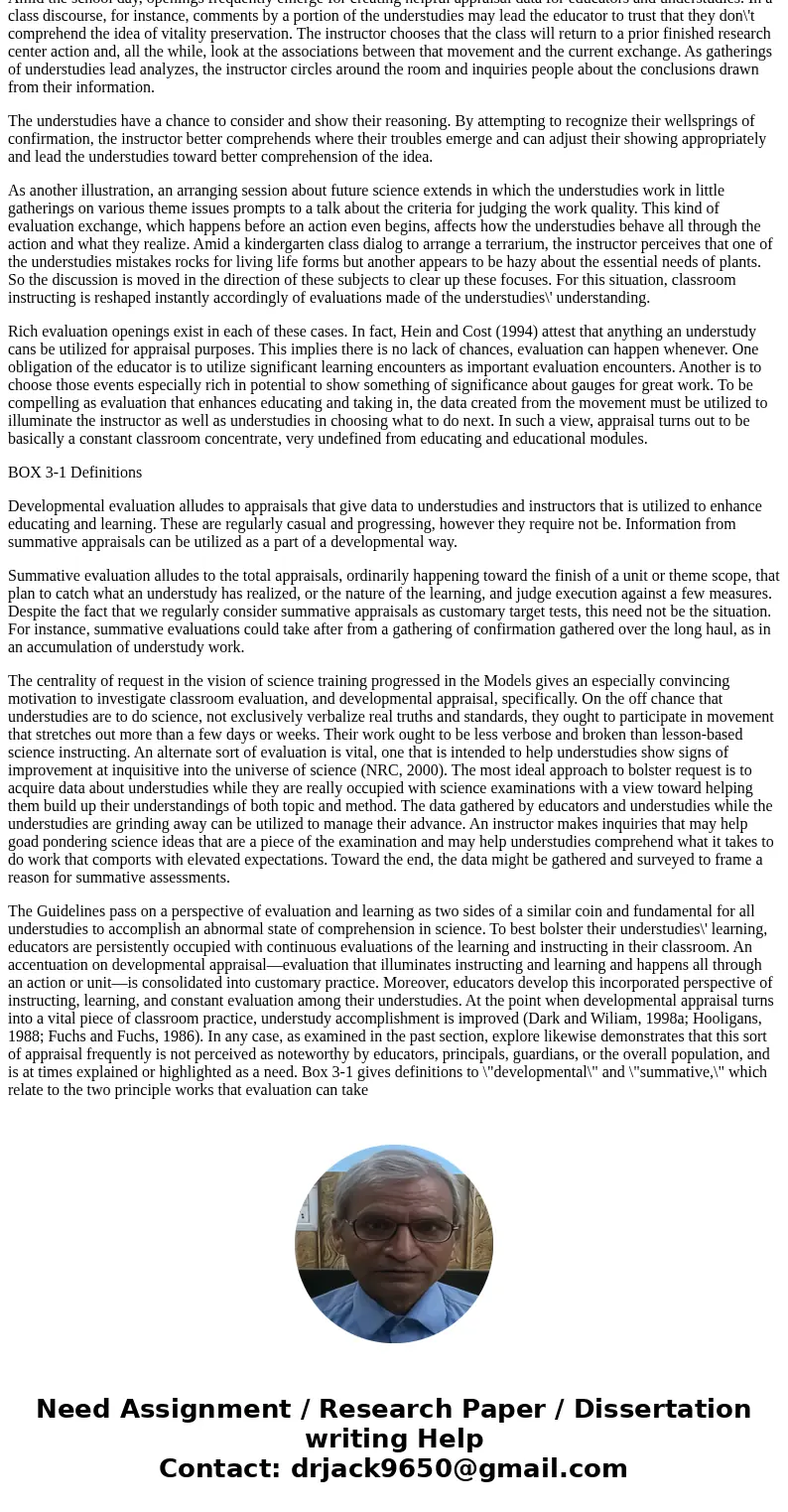fileCUsersrosajAppDataLocalTempHillNuth2003catalyticpotentia
file:///C:/Users/rosaj/AppData/Local/Temp/Hill_Nuth_2003_catalytic_potential_cosmic_dust_prebiotic_chemsitry_protoplanetary_systems_astrobiology.pdf
create a peer critique analyzing the data and conclusions of this paper and include ways they could improve using scientific notation. and include what further research could be done base on their result and conclusions.
Solution
The essential groups of onlookers for this section are classroom instructors and educator teachers. The part offers a controlling structure to utilize while considering regular appraisals and afterward examines the parts and obligations of instructors and understudies in enhancing evaluation. Directors likewise might be occupied with the material displayed in this section.
Evaluation more often than not evokes pictures of an end-of-unit test, a quarterly report card, a state-level examination on essential aptitudes, or the letter review for a last research center report. Be that as it may, these commonplace parts of evaluation don\'t catch the full degree or nuance of how appraisal works each day in the classroom. The sort of classroom appraisal talked about in this section centers upon the every day openings and collaborations stood to instructors and understudies for gathering data about understudy work and understandings, then uses that data to enhance both educating and learning. It is a characteristic piece of classroom life that is a world far from formal examinations—both in soul and in reason.
Amid the school day, openings frequently emerge for creating helpful appraisal data for educators and understudies. In a class discourse, for instance, comments by a portion of the understudies may lead the educator to trust that they don\'t comprehend the idea of vitality preservation. The instructor chooses that the class will return to a prior finished research center action and, all the while, look at the associations between that movement and the current exchange. As gatherings of understudies lead analyzes, the instructor circles around the room and inquiries people about the conclusions drawn from their information.
The understudies have a chance to consider and show their reasoning. By attempting to recognize their wellsprings of confirmation, the instructor better comprehends where their troubles emerge and can adjust their showing appropriately and lead the understudies toward better comprehension of the idea.
As another illustration, an arranging session about future science extends in which the understudies work in little gatherings on various theme issues prompts to a talk about the criteria for judging the work quality. This kind of evaluation exchange, which happens before an action even begins, affects how the understudies behave all through the action and what they realize. Amid a kindergarten class dialog to arrange a terrarium, the instructor perceives that one of the understudies mistakes rocks for living life forms but another appears to be hazy about the essential needs of plants. So the discussion is moved in the direction of these subjects to clear up these focuses. For this situation, classroom instructing is reshaped instantly accordingly of evaluations made of the understudies\' understanding.
Rich evaluation openings exist in each of these cases. In fact, Hein and Cost (1994) attest that anything an understudy cans be utilized for appraisal purposes. This implies there is no lack of chances, evaluation can happen whenever. One obligation of the educator is to utilize significant learning encounters as important evaluation encounters. Another is to choose those events especially rich in potential to show something of significance about gauges for great work. To be compelling as evaluation that enhances educating and taking in, the data created from the movement must be utilized to illuminate the instructor as well as understudies in choosing what to do next. In such a view, appraisal turns out to be basically a constant classroom concentrate, very undefined from educating and educational modules.
BOX 3-1 Definitions
Developmental evaluation alludes to appraisals that give data to understudies and instructors that is utilized to enhance educating and learning. These are regularly casual and progressing, however they require not be. Information from summative appraisals can be utilized as a part of a developmental way.
Summative evaluation alludes to the total appraisals, ordinarily happening toward the finish of a unit or theme scope, that plan to catch what an understudy has realized, or the nature of the learning, and judge execution against a few measures. Despite the fact that we regularly consider summative appraisals as customary target tests, this need not be the situation. For instance, summative evaluations could take after from a gathering of confirmation gathered over the long haul, as in an accumulation of understudy work.
The centrality of request in the vision of science training progressed in the Models gives an especially convincing motivation to investigate classroom evaluation, and developmental appraisal, specifically. On the off chance that understudies are to do science, not exclusively verbalize real truths and standards, they ought to participate in movement that stretches out more than a few days or weeks. Their work ought to be less verbose and broken than lesson-based science instructing. An alternate sort of evaluation is vital, one that is intended to help understudies show signs of improvement at inquisitive into the universe of science (NRC, 2000). The most ideal approach to bolster request is to acquire data about understudies while they are really occupied with science examinations with a view toward helping them build up their understandings of both topic and method. The data gathered by educators and understudies while the understudies are grinding away can be utilized to manage their advance. An instructor makes inquiries that may help goad pondering science ideas that are a piece of the examination and may help understudies comprehend what it takes to do work that comports with elevated expectations. Toward the end, the data might be gathered and surveyed to frame a reason for summative assessments.
The Guidelines pass on a perspective of evaluation and learning as two sides of a similar coin and fundamental for all understudies to accomplish an abnormal state of comprehension in science. To best bolster their understudies\' learning, educators are persistently occupied with continuous evaluations of the learning and instructing in their classroom. An accentuation on developmental appraisal—evaluation that illuminates instructing and learning and happens all through an action or unit—is consolidated into customary practice. Moreover, educators develop this incorporated perspective of instructing, learning, and constant evaluation among their understudies. At the point when developmental appraisal turns into a vital piece of classroom practice, understudy accomplishment is improved (Dark and Wiliam, 1998a; Hooligans, 1988; Fuchs and Fuchs, 1986). In any case, as examined in the past section, explore likewise demonstrates that this sort of appraisal frequently is not perceived as noteworthy by educators, principals, guardians, or the overall population, and is at times explained or highlighted as a need. Box 3-1 gives definitions to \"developmental\" and \"summative,\" which relate to the two principle works that evaluation can take


 Homework Sourse
Homework Sourse